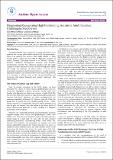Diagnosing/recognising high functioning autism in adult females : challenging stereotypes
Date
03/06/2016Metadata
Show full item recordAbstract
The apparent global rise in Autism has led many to describe it as an epidemic and a major public health concern [1-4]. The extraordinary claim of an epidemic has, however, been widely refuted [5]. Most recently DSM-V unified the four DSM-IV diagnostic categories of Autistic Disorder (“previously referred to as “Autism”), Asperger’s Disorder, is Childhood Disintegrative Disorder, and Pervasive Developmental Disorder Not Otherwise Specified, into the single category of Autistic Spectrum Disorder. This shift in diagnostic criteria will change the landscape of autism further, in terms of its presentation, prevalence, and treatment. However, in order to ensure appropriate diagnosis and treatment/intervention across the spectrum, it necessary to address some of the mis-understandings and stereotypes that plague diagnostic and research endeavours with regards autism.
Citation
Evans-Williams , C V M & Williams , D J 2016 , ' Diagnosing/recognising high functioning autism in adult females : challenging stereotypes ' , Autism-Open Access , vol. 6 , no. 3 , 1000179 . https://doi.org/10.4172/2165-7890.1000179
Publication
Autism-Open Access
Status
Peer reviewed
ISSN
2165-7890Type
Journal article
Collections
Items in the St Andrews Research Repository are protected by copyright, with all rights reserved, unless otherwise indicated.

